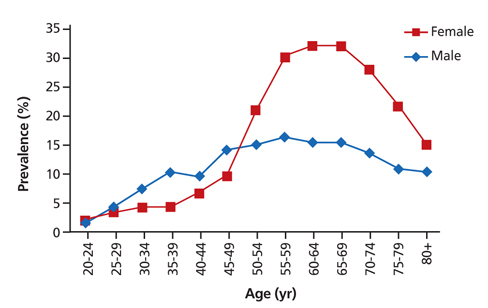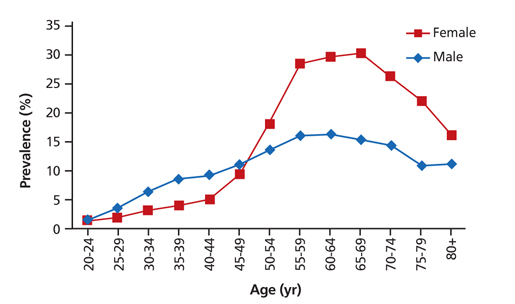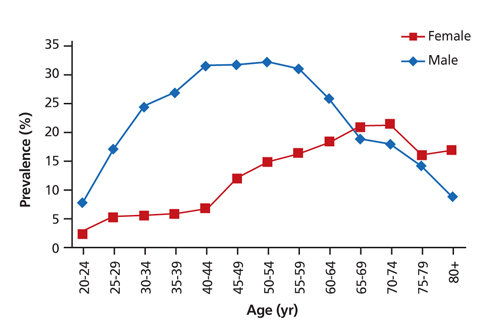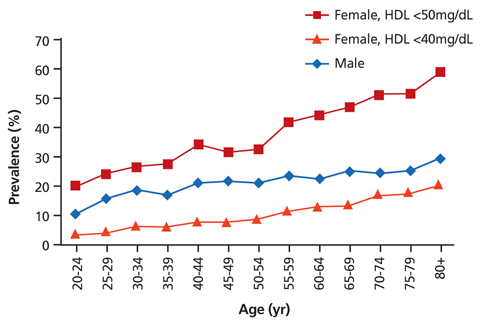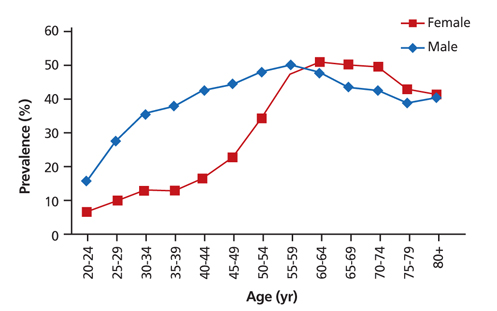Epidemiology of dyslipidemia in Korea
- Affiliations
-
- 1Department of Preventive Medicine, Yonsei University College of Medicine, Seoul, Korea. hckim@yuhs.ac
- KMID: 2420633
- DOI: http://doi.org/10.5124/jkma.2016.59.5.352
Abstract
- Cardiovascular disease is the leading cause of death worldwide and the second most common cause of death in Korea. Dyslipidemia is among the major modifiable risk factors for cardiovascular disease. To develop effective guidelines for the management of dyslipidemia, it is important to understand the epidemiologic characteristics of dyslipidemia in the target population. The prevalence of dyslipidemia in the Korean population has been reported variously from 30% to higher than 60%, but, in general, the prevalence of dyslipidemia among Koreans has been increasing. Among the subtypes of dyslipidemia, hypercholesterolemia and hyper-LDL cholesterolemia are relatively uncommon in Korea compared to other high-income countries. On the other hand, hypertriglyceridemia and hypo-HDL cholesterolemia are very common in Korea. Recent data shows that total and LDL cholesterol levels are increasing in the Korean population, while triglyceride and HDL cholesterol levels have not been changing. As a consequence, the prevalence of hypercholesterolemia and hyper-LDL cholesterolemia is increasing. These data reinforce the need to make a greater effort toward the prevention and treatment of dyslipidemia.
Keyword
MeSH Terms
Figure
Cited by 6 articles
-
Achievement of LDL-C Targets Defined by ESC/EAS (2011) Guidelines in Risk-Stratified Korean Patients with Dyslipidemia Receiving Lipid-Modifying Treatments
Ye Seul Yang, Seo Young Lee, Jung-Sun Kim, Kyung Mook Choi, Kang Wook Lee, Sang-Chol Lee, Jung Rae Cho, Seung-Jin Oh, Ji-Hyun Kim, Sung Hee Choi
Endocrinol Metab. 2020;35(2):367-376. doi: 10.3803/EnM.2020.35.2.367.Fibrates Revisited: Potential Role in Cardiovascular Risk Reduction
Nam Hoon Kim, Sin Gon Kim
Diabetes Metab J. 2020;44(2):213-221. doi: 10.4093/dmj.2020.0001.2018 Guidelines for the Management of Dyslipidemia in Korea
Eun-Jung Rhee, Hyeon Chang Kim, Jae Hyeon Kim, Eun Young Lee, Byung Jin Kim, Eun Mi Kim, YoonJu Song, Jeong Hyun Lim, Hae Jin Kim, Seonghoon Choi, Min Kyong Moon, Jin Oh Na, Kwang-Yeol Park, Mi Sun Oh, Sang Youb Han, Junghyun Noh, Kyung Hee Yi, Sang-Hak Lee, Soon-Cheol Hong, In-Kyung Jeong,
J Lipid Atheroscler. 2019;8(2):78-131. doi: 10.12997/jla.2019.8.2.78.Relationship between health behaviors and high level of low density lipoprotein-cholesterol applying cardiovascular risk factors among Korean adults: based on the sixth Korea National Health and Nutrition Examination Survey (KNHANES VI), 2013 ~ 2015
Bo-Kyoung Cha
J Nutr Health. 2018;51(6):556-566. doi: 10.4163/jnh.2018.51.6.556.Identifying Latent Classes of Risk Factors for Coronary Artery Disease
Eunsil Ju, JiSun Choi
J Korean Acad Nurs. 2017;47(6):817-827. doi: 10.4040/jkan.2017.47.6.817.Changes in Target Achievement Rates after Statin Prescription Changes at a Single University Hospital
Seon Choe, Jiwon Shinn, Hun-Sung Kim, Ju Han Kim
Cardiovasc Prev Pharmacother. 2020;2(3):103-111. doi: 10.36011/cpp.2020.2.e14.
Reference
-
1. World Health Organization. Global Health Observatory (GHO) data [Internet]. Geneva: World Health Organization;2012. cited 2016 Apr 25. Available from: http://www.who.int/gho/ncd/mortality_morbidity/ncd_total/en/index.html.2. World Health Organization. Preventing chronic diseases: a vital investment [Internet]. Geneva: World Health Organization;2005. cited 2016 Apr 25. Available from: http://www.who.int/chp/chronic_disease_report/en.3. Beaglehole R, Bonita R, Horton R, Adams C, Alleyne G, Asaria P, Baugh V, Bekedam H, Billo N, Casswell S, Cecchini M, Colagiuri R, Colagiuri S, Collins T, Ebrahim S, Engelgau M, Galea G, Gaziano T, Geneau R, Haines A, Hospedales J, Jha P, Keeling A, Leeder S, Lincoln P, McKee M, Mackay J, Magnusson R, Moodie R, Mwatsama M, Nishtar S, Norrving B, Patterson D, Piot P, Ralston J, Rani M, Reddy KS, Sassi F, Sheron N, Stuckler D, Suh I, Torode J, Varghese C, Watt J. Lancet NCD Action Group. NCD Alliance. Priority actions for the noncommunicable disease crisis. Lancet. 2011; 377:1438–1447.
Article4. Lee SW, Kim HC, Lee HS, Suh I. Thirty-year trends in mortality from cardiovascular diseases in Korea. Korean Circ J. 2015; 45:202–209.
Article5. Lee SW, Kim HC, Lee HS, Suh I. Thirty-year trends in mortality from cerebrovascular diseases in Korea. Korean Circ J. 2016; 46:e85.
Article6. Ministry of Health and Welfare. Korea Centers for Disease Control and Prevention. Korea health statistics 2012: Korea National Health and Nutrition Examination Survey (KNHANES V-3). Seoul: Ministry of Health and Welfare;2013.7. Hong JS, Kang HC, Lee SH, Kim J. Long-term trend in the incidence of acute myocardial infarction in Korea: 1997-2007. Korean Circ J. 2009; 39:467–476.
Article8. Kim RB, Kim BG, Kim YM, Seo JW, Lim YS, Kim HS, Lee HJ, Moon JY, Kim KY, Shin JY, Park HK, Song JK, Park KS, Jeong BG, Park CG, Shin HY, Kang JW, Oh GJ, Lee YH, Seong IW, Yoo WS, Hong YS. Trends in the incidence of hospitalized acute myocardial infarction and stroke in Korea, 2006-2010. J Korean Med Sci. 2013; 28:16–24.
Article9. Ecological analysis of the association between mortality and major risk factors of cardiovascular disease: The World Health Organization MONICA Project. Int J Epidemiol. 1994; 23:505–516.10. Kim HC, Oh SM. Noncommunicable diseases: current status of major modifiable risk factors in Korea. J Prev Med Public Health. 2013; 46:165–172.
Article11. Park JH, Lee MH, Shim JS, Choi DP, Song BM, Lee SW, Choi H, Kim HC. Effects of age, sex, and menopausal status on blood cholesterol profile in the Korean population. Korean Circ J. 2015; 45:141–148.
Article12. Kim KI. Dyslipidemia in older adults and management of dyslipidemia in older patients. J Lipid Atheroscler. 2015; 4:1–6.
Article13. Statistics Korea. Population projections for Korea: 2010-2060. Daejeon: Statistics Korea;2011.14. Ha KH, Kwon HS, Kim DJ. Epidemiologic characteristics of dyslipidemia in Korea. J Lipid Atheroscler. 2015; 4:93–99.
Article15. Lee MH, Kim HC, Ahn SV, Hur NW, Choi DP, Park CG, Suh I. Prevalence of dyslipidemia among Korean adults: Korea National Health and Nutrition Survey 1998-2005. Diabetes Metab J. 2012; 36:43–55.
Article16. Roh E, Ko SH, Kwon HS, Kim NH, Kim JH, Kim CS, Song KH, Won JC, Kim DJ, Choi SH, Lim S, Cha BY. Taskforce Team of Diabetes Fact Sheet of the Korean Diabetes Association. Prevalence and management of dyslipidemia in Korea: Korea National Health and Nutrition Examination Survey during 1998 to 2010. Diabetes Metab J. 2013; 37:433–449.
Article17. Committee for Guidelines for Management of Dyslipidemia. 2015 Korean Guidelines for Management of Dyslipidemia. J Lipid Atheroscler. 2015; 4:61–92.
- Full Text Links
- Actions
-
Cited
- CITED
-
- Close
- Share
- Similar articles
-
- Post-Renal Transplantation Dyslipidemia
- Epidemiologic Characteristics of Dyslipidemia in Korea
- Dyslipidemia in Children and Adolescents: When and How to Diagnose and Treat?
- The Comparison of Guidelines for Management of Dyslipidemia and the Appropriateness of Them in Korea
- Screening and Management for Dyslipidemia in Korean Children and Adolescents

